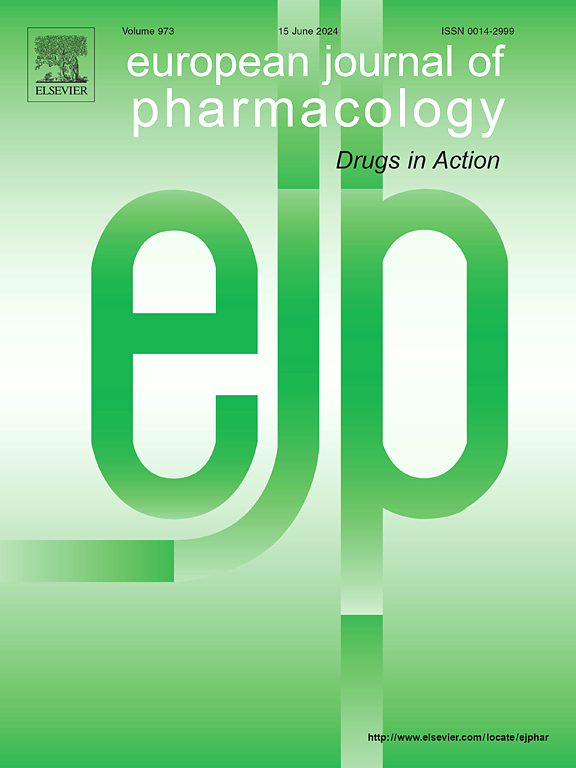The cannabinoid CB2 receptor: improvement of sleep or memory in rotenone model of Parkinson's disease
IF 4.2
3区 医学
Q1 PHARMACOLOGY & PHARMACY
引用次数: 0
Abstract
The impact of cannabinoid CB2 receptor modulation on the non-motor symptoms of Parkinson's disease remains unknown. We investigated the role of nigrostriatal CB2 receptors modulation in reversing alterations in sleep macrostructure, inter-hemispheric synchronization dynamics, and memory consolidation in the rotenone model of Parkinson's disease. Male Wistar rats (n = 65) underwent stereotaxic surgery for the administration of either rotenone (12 μg/μl) or dimethyl sulfoxide (vehicle, 10 % v/v) into the substantia nigra pars compacta. Seven days later, the rotenone-treated animals received intrastriatal injections of either dimethyl sulfoxide (vehicle, 10 % v/v), GW405833 (partial agonist of CB2 receptors, 10 μg/μl), or AM630 (antagonist/inverse agonist of CB2 receptors, 3 μg/μl). One group of animals underwent 6 h of sleep-wake recording, while another group performed object recognition and open field tests. Real-time polymerase chain reaction was conducted to determine striatal transcript levels of CB1 and CB2 receptors. Infusion of AM630 reversed the rotenone-induced alterations in sleep macrostructure and inter-hemispheric synchronization dynamics. This modulation led to increased sleep efficiency (p < 0.01), higher probability of shorter desynchronization events (p < 0.01), and reduced transition rate from synchronized to desynchronized states (p < 0.05). Conversely, GW405833, but not AM630, reversed the rotenone-induced impairment in object recognition memory (p < 0.01). No significant effects were observed on striatal cannabinoid receptors transcripts levels. These findings suggest that CB2 receptors modulation is associated with paradoxical outcomes in terms of non-motor signs of Parkinson's disease, indicating somewhat independent mechanisms underlying sleep and memory alterations in the rotenone model of the disease.
大麻素CB2受体:改善帕金森病鱼藤酮模型的睡眠或记忆。
大麻素CB2受体调节对帕金森病非运动症状的影响尚不清楚。我们在鱼藤酮帕金森病模型中研究了黑质纹状体CB2受体调节在逆转睡眠宏观结构改变、半球间同步动力学和记忆巩固中的作用。雄性Wistar大鼠(n = 65)采用立体定向手术,将鱼藤酮(12 μg/μl)或二甲亚砜(对照物,10% v/v)注入黑质致密部。7天后,鱼藤酮处理的动物分别接受二甲亚胺(对照物,10% v/v)、GW405833 (CB2受体部分激动剂,10 μg/μl)或AM630 (CB2受体拮抗剂/逆激动剂,3 μg/μl)的腔内注射。一组动物进行了6小时的睡眠-觉醒记录,而另一组进行了物体识别和野外测试。实时聚合酶链反应测定纹状体CB1和CB2受体转录水平。注射AM630逆转鱼藤酮引起的睡眠宏观结构和半球间同步动力学的改变。这种调节导致睡眠效率提高(p < 0.01),短时间非同步事件的可能性增加(p < 0.01),从同步状态到非同步状态的转换率降低(p < 0.05)。相反,GW405833能逆转鱼藤酮引起的物体识别记忆损伤,而AM630不能(p < 0.01)。纹状体大麻素受体转录水平未见显著影响。这些发现表明,CB2受体调节与帕金森病非运动症状的矛盾结果有关,表明鱼藤酮模型中睡眠和记忆改变的某种独立机制。
本文章由计算机程序翻译,如有差异,请以英文原文为准。
求助全文
约1分钟内获得全文
求助全文
来源期刊
CiteScore
9.00
自引率
0.00%
发文量
572
审稿时长
34 days
期刊介绍:
The European Journal of Pharmacology publishes research papers covering all aspects of experimental pharmacology with focus on the mechanism of action of structurally identified compounds affecting biological systems.
The scope includes:
Behavioural pharmacology
Neuropharmacology and analgesia
Cardiovascular pharmacology
Pulmonary, gastrointestinal and urogenital pharmacology
Endocrine pharmacology
Immunopharmacology and inflammation
Molecular and cellular pharmacology
Regenerative pharmacology
Biologicals and biotherapeutics
Translational pharmacology
Nutriceutical pharmacology.

 求助内容:
求助内容: 应助结果提醒方式:
应助结果提醒方式:


